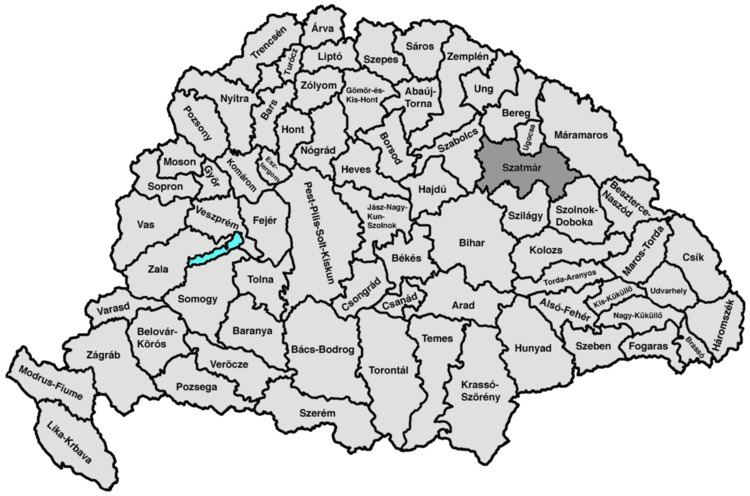Capital Nagykároly 1910 6,287 km (2,427 sq mi) | Established 11th century 1910 396,632 | |
 | ||
Szatmár County (Hungarian: Szatmár vármegye [ˈsɒtmaːr ˈvaːrmɛɟɛ]) was an administrative county (comitatus) of the Kingdom of Hungary. Its territory is now in north-western Romania and north-eastern Hungary, south of the river Tisza. The capital of the county was Nagykároly, today called Carei (in Romanian).
Contents
Geography
After 1876 Szatmár county shared borders with the former Hungarian counties Szabolcs, Bereg, Ugocsa, Máramaros, Szolnok-Doboka, Szilágy and Bihar. It was situated south of the river Tisza. The river Szamos flowed through the county. Its area was 6257 km² around 1910.
History
In 1920 the Treaty of Trianon assigned most of the territory of the county to Romania, while Velika Palad (formerly Nagypalád) village was passed to Czechoslovakia in 1921 after border adjustment agreement with Romania. According to the agreement also Akli (now Okli) and Fertősalmás (it was known as Ferkeš-Almaš in Romania and Czechoslovakia, now Fertesolmas) villages were passed to Czechoslovakia; whereas Bocskó (Bočkov in Czech, now Bocicău), Ugocsakomlós (Komlóš in Czech, now Comlăușa), Avaspatak (Suchý Potok in Czech, now Valea Seacă), Nagytarna (Veľkú Terna in Czech, now Tarna Mare) ones and several municipalities in Podkarpat Rus were passed to Romania. The northwest of the county remained in Hungary, and formed the new county Szatmár-Ugocsa-Bereg with parts of the former Bereg and Ugocsa counties. The capital of this county was Mátészalka, which was previously in Szatmár county. According to First Vienna Award Velika Palad was returned to Hungary but passed to USSR in 1945. Romanian part of it was returned to Hungary by the Second Vienna Award in 1940 until the end of World War II when it became again part of Romania.
After World War II, the county Szatmár-Ugocsa-Bereg was merged with Szabolcs county to form Szabolcs-Szatmár county. This county was renamed Szabolcs-Szatmár-Bereg in the 1990s.
The Romanian part of the county is now part of the Romanian county Satu Mare, except the easternmost part (including Baia Mare), which is in Maramureş county.
Demographics
In 1900, the county had a population of 367,570 people and was composed of the following linguistic communities:
According to the census of 1900, the county was composed of the following religious communities:
In 1910, county had a population of 396,632 people and was composed of the following linguistic communities:
According to the census of 1910, the county was composed of the following religious communities:
Subdivisions
In the early 20th century, the subdivisions of Szatmár county were:
Csenger, Fehérgyarmat and Mátészalka are now in Hungary; the other towns mentioned are now in Romania.
